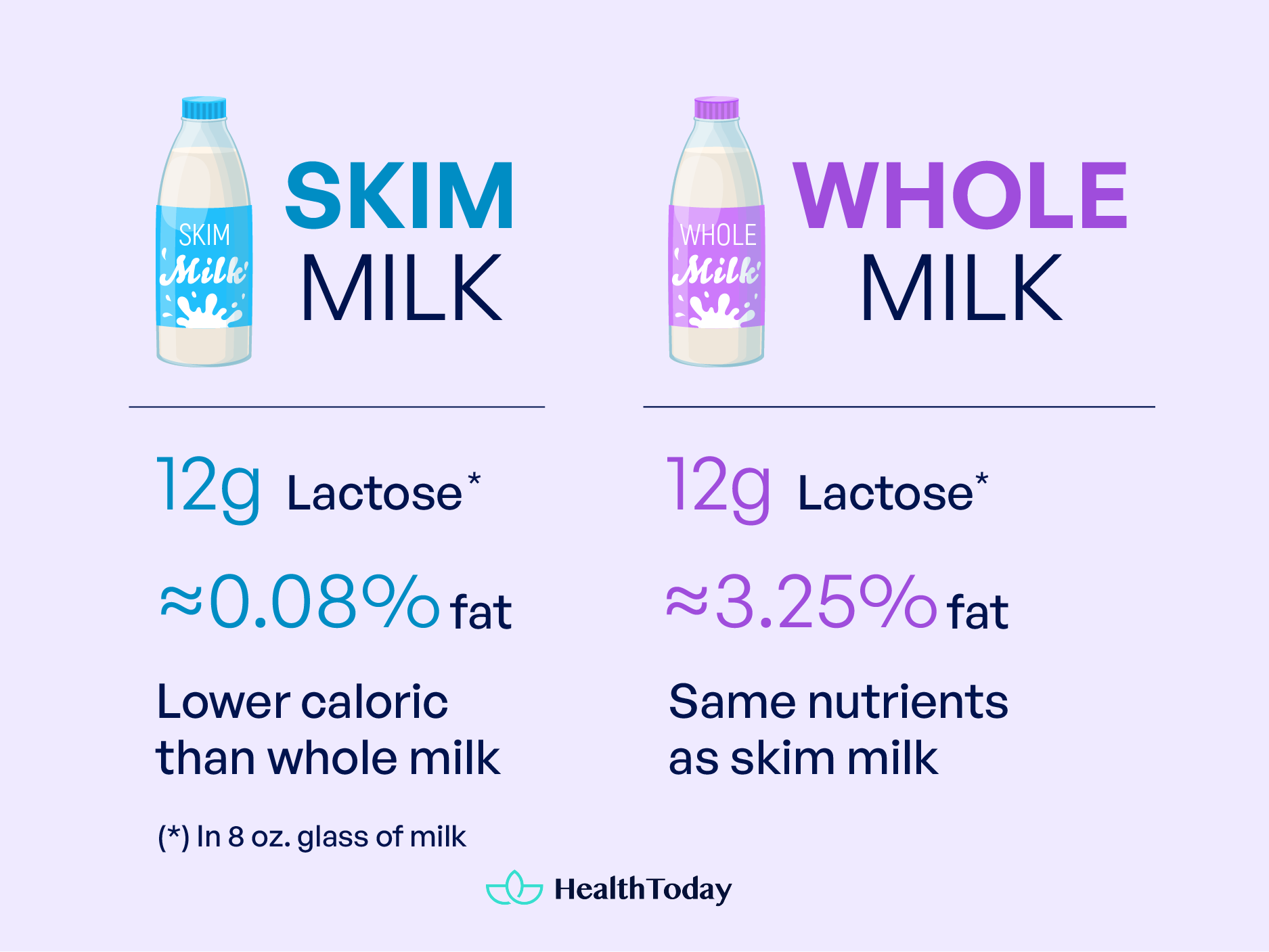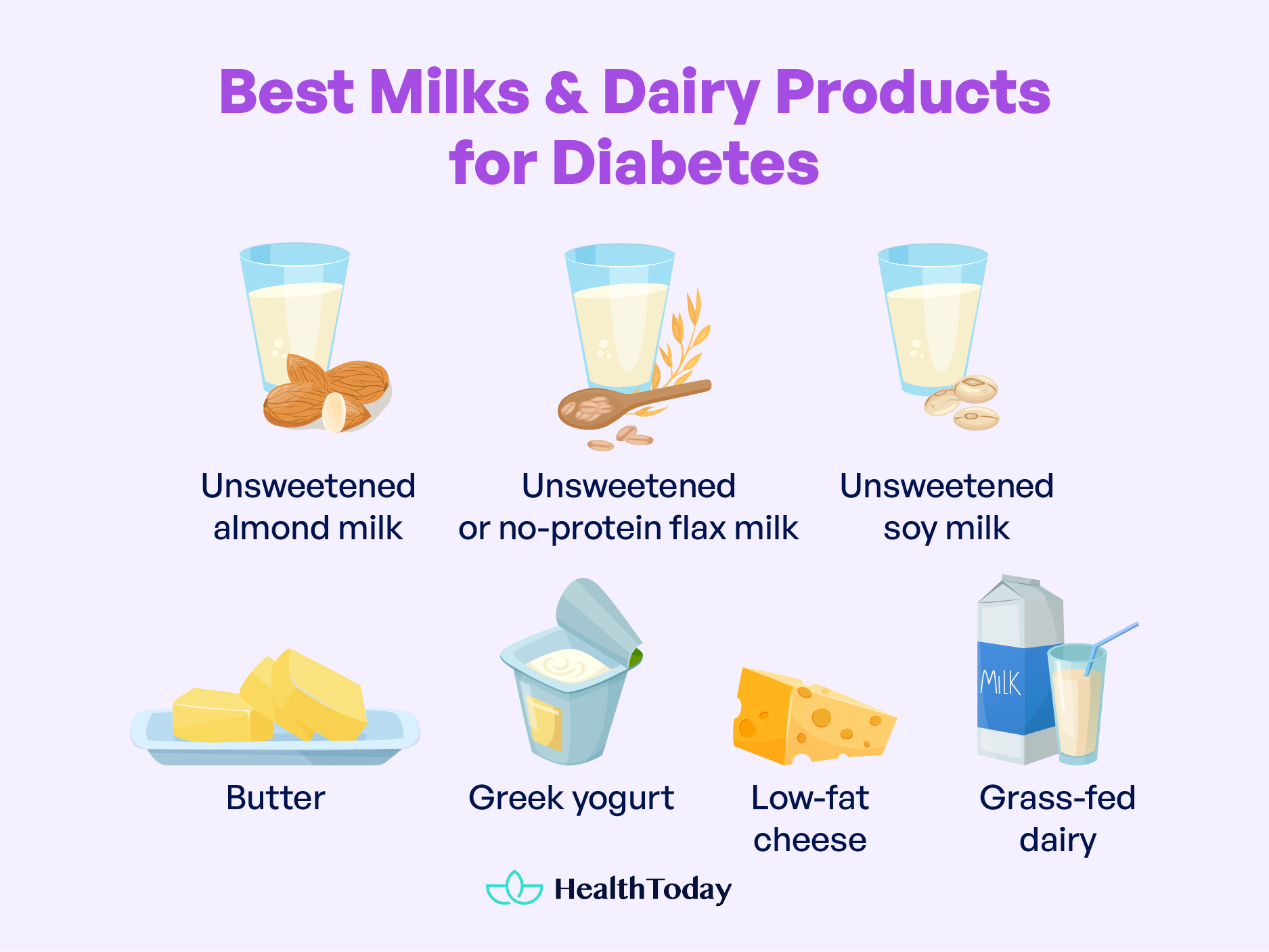Table of Contents
Milk has been promoted as a super drink that can boost your growth and make you taller. While the promises of extra inches were enticing, have you ever wondered how much sugar is in milk? Or do you prefer milk with less sugar? If someone has diabetes, what is the best milk for diabetics?
In this article, we’ll discuss these questions one by one.
Does milk have sugar?
Yes, and the sugar content in milk varies greatly depending on its source. Due to the various types of milk, you might consider rephrasing the question from “Is there sugar in milk?” to “Is there sugar in [specific type of milk]?”.
You can also ask, “Is the sugar in milk bad?” to compare the effects of different kinds of milk. In the following section, let’s take two common cow’s milk, skim, and whole milk, as examples.

Sugar in skim milk
Skim milk is also known as fat-free milk, which contains fewer calories and less fat. However, have you ever thought about how much sugar is in skim milk? If it’s healthier than other kinds of milk, is skim milk good for diabetics?
There are about 12 grams of natural sugar (lactose) in each 8-ounce glass of skim milk (1). These naturally occurring sugars can also be found in fruits, offering nutritious vitamins, minerals, protein, fiber, or bioactives to benefit our health.
Sugar in whole milk
Whole milk is also known as full-fat or “3% milk.” There are also about 12 grams of natural sugar (lactose) in each 8-ounce glass of whole milk (2). It also provides us with many nutrients, like skim milk. So, the biggest difference between the two is that whole milk has a higher fat content, approximately 3.25% (2).
Is skim milk better for diabetics than whole milk?
Yes, skim milk is a better choice than whole milk for people with diabetes since it contains lower caloric content to prevent weight gain. But whether it’s skim milk or whole milk, they both have the same amount of natural sugar called lactose.
Overeating sugar can be harmful for people with diabetes, especially when it comes to their kidneys. An important task of the kidneys is cleaning the blood. When the sugar levels in the blood get too high, the kidneys start pushing the extra sugar into the urine.
If diabetes isn’t managed properly, the kidneys will have a hard time doing their job of removing waste from the blood, which can eventually lead to kidney failure (3).
Measure with glycemic index: What milk is best for diabetics
Milk, whether a regular or a non-dairy alternative, contains a natural sugar called lactose, and we can measure how it affects blood sugar using the glycemic index.
Milk alternatives, such as coconut and various nut beverages, contain a sugar called fructose.
While some plant-based milk alternative beverages have less sugar, many have more sugar and a higher glycemic index than cow’s milk. Besides, most of these milk alternative beverages have lower nutritional quality than cow’s milk. Therefore, be careful about choosing a plant-based milk substitute, and always choose unsweetened or plain milk-alternative beverages (4, 5).
A review of 18 studies involving 209 people with diabetes found that when they replaced other carbs with fructose, their Hemoglobin A1C levels decreased by about 0.53% over three months, but this was only significant in persons with type 1 diabetes (4). But there’s a catch: fructose might increase triglyceride levels and cause some troubles in the stomach, like gas and bloating in certain individuals (4).
Milk, regardless of type, contains a natural sugar called lactose. Skim milk is a better option for diabetics due to its lower calorie content.
All types of milk affect blood sugar. Some milk alternatives, like coconut and nut beverages, have low-GI fructose, possibly beneficial for diabetes. Still, many of these beverages may have added sugar or a higher overall GI index than cow’s milk, so be careful when using them as an alternative in your diet.
Replacing carbs with fructose may help lower your A1C, but it can increase triglycerides and cause digestive discomfort.
Why does milk contain sugar?
The lactose in milk is important for our body and brain as an energy source. It’s especially important for brain development in babies and children (5, 6).
If your body doesn’t fully digest lactose, it will feed the healthy bacteria in your gut. Undigested lactose also helps your body absorb important minerals like calcium and magnesium. So, whether it’s the lactose in regular milk or other sugars in non-dairy milk, they both benefit our overall health (6).
But with all kinds of milk available in the market, how do you choose the healthier one? How can you tell if there’s added sugar in the milk?
Decoding food labels: Distinguishing natural sugar from added sugar
Since 2020, the Food and Drug Administration (FDA) in the United States has made it easier to identify which milk to buy or avoid by redesigning food labels (7).
Common names for added sugar include:
- Corn syrup or high-fructose corn syrup
- Agave nectar
- Coconut sugar
- Barley malt
- Maltose
- Fructose
But outside of the United States, nutrition labels may vary in detail and should be read carefully.
Sugar in milk is an important source of energy for the body. However, it’s important to tell whether the sugar in milk is natural or added. The most direct and simple way is to check the food label.
The best milk for diabetics
In the previous discussion, we mainly talked about milk that might not be ideal for people with diabetes. But what exactly is the connection between diabetes and milk? Is milk only bad for diabetics? If not, what is the best milk for diabetics?
Milk for type 2 diabetes
Type 2 diabetes (T2D) occurs when your blood sugar is too high. People with type 2 diabetes don’t make enough insulin or don’t use it properly, causing too much sugar to stay in the blood and not enough to reach the cells (8).
Various studies have suggested that dairy product consumption is associated with a lower risk of T2D, especially yogurt and low-fat dairy (9, 10, 11, 12). This also highlights the importance of choosing the right kind of milk to ingest for people with diabetes
Soy milk for diabetics
Soy milk is derived from soybeans and filtered water, similar to other plant-based milk beverages, which might include thickeners for better texture and longevity.
Since soy milk is plant-based, it is naturally cholesterol-free and low in saturated fat, and it contains no lactose.
If you’re managing diabetes and want to drink some milk, unsweetened soy milk is a great choice, as it is a healthy beverage.
Powder milk for diabetes: Is it good?
Powdered milk is made by removing the liquid from regular milk, leaving behind about 40% milk solids. This process keeps the milk from clumping and lowers its moisture content.
In a study, researchers examined how milk powder with added inulin and resistant dextrin (MPCIR) affected elderly patients with type 2 diabetes (13). The study found that taking MPCIR helped these patients control their blood sugar, improve their insulin resistance, and lower their blood pressure (13).
Time and how to drink milk for people with diabetes
Enhancing blood sugar control at breakfast
In one study, researchers looked into how different types of protein in milk could affect blood sugar, satiety, and food intake after a high-carb breakfast. They found that milk with more whey protein helps control blood sugar, and having high-protein milk was even better (14).
Milk with extra whey protein also lowered blood sugar before lunch compared to regular milk. This study emphasizes the importance of including milk in your breakfast for better blood sugar control (14).
Milk for diabetics: Consider calcium and carbohydrate intake
For adults aged 19 to 51, it’s recommended to ingest about 1,000mg of calcium in your daily diet (15). Low-fat cow’s milk has approximately 300 mg of calcium, and other dairy products have more.
When it comes to carbohydrates, the CDC suggests that individuals managing diabetes should get around 45% of their daily total calories from carbohydrates (16), but it can be different based on gender.
Since there’s no fixed rule for how many carbs are right for all diabetics, it is always suggested to consult a healthcare expert to help you find the best diet for your situation.
Low-fat dairy, like yogurt, reduces the risk of type 2 diabetes. Unsweetened soy milk and powdered milk with added inulin are good for diabetics. Adding milk with whey protein to breakfast aids blood sugar control.
Consider calcium and carbs when selecting milk, but consult healthcare experts for personalized diabetes-friendly dietary advice.
Milk with less sugar – which is the best?
If you’re unsure about cow’s milk for diabetes, there are other milk options to consider. Just remember, these should be unsweetened. Adding sugar means more carbs, which raises your blood sugar.

Best milk for diabetes: unsweetened milk
- Unsweetened almond milk: It has only 2% carbs, much less than low-fat cow’s milk at 5%.
- Unsweetened or no-protein flax milk: It’s incredibly low in carbs, with just 1.02g. It’s heart-healthy with no lactose or cholesterol.
- Unsweetened soy milk: With 4.01g of carbs, it’s a safe non-dairy option for diabetics.
Dairy products for people with diabetes
Other than milk, you can still enjoy some dairy products if you have diabetes:
- Butter: Butter has a low glycemic index (GI). Diabetics can have it in moderation but consider healthier oils like olive or avocado due to butter’s high saturated fat content, which may raise heart disease risk.
- Greek yogurt: It’s a good choice due to the probiotics that can benefit your gut health and help regulate glucose and insulin levels.
- Low-fat cheese: Options like string cheese, cottage cheese, or ricotta provide low-fat protein that won’t significantly affect blood glucose levels.
- Grass-fed dairy: Milk from grass-fed cows contains higher levels of alpha-linolenic acid, an omega-3 fatty acid. And you can tell it from the label.
Opt for unsweetened choices like almond milk (2% carbs), flax milk (1.02g carbs), or soy milk (4.01g carbs). For diabetics, other suitable dairy options include Greek yogurt, low-fat cheese, and grass-fed dairy with alpha-linolenic acid.
Is skim milk good for diabetics?
Compared to whole milk, skim milk is better. However, other unsweetened options like almond milk and unsweetened soy milk contain fewer carbohydrates and may be better for diabetics. However, alternative kinds of milk may have fewer nutrients or protein, so read labels carefully.
How much sugar is in 2 percent milk?
There are about 12 grams of natural sugar (lactose) per 8-ounce glass of 2 percent milk (reduced-fat milk).
Is milk sweet?
Yes, one cup of white milk (250 ml) contains 12 grams of naturally occurring lactose sugar. It gives milk a slightly sweet taste.
Is Fairlife milk good for diabetics?
These milk are higher in protein and contain half the carbs of regular dairy milk. So, compared to full-fat milk, they are indeed better for diabetics and those who need to monitor their carbohydrate intake closely. However, total intake should still be considered.
Can diabetics drink milk in the morning?
Yes. A study found that high-protein milk at breakfast can help diabetics control blood glucose, offering potential benefits for type 2 diabetes management.
Summary
Let’s wrap up what we have covered today:
- Naturally, milk has a sugar called lactose, which is a source of energy for the body, and it’s important to distinguish between natural and added sugars.
- The best alternative milk for diabetics would be milk with less sugar or unsweetened. Options like unsweetened almond milk and unsweetened soy milk.
- Plant-based options like coconut and nut milk with low-GI fructose can also help manage blood sugar levels.
- Sugar in skim milk and whole milk are both about 12 grams of natural sugar (lactose) per 8-ounce glass, but whole milk has more fat.
- Soy milk is suitable for individuals with diabetes due to its low saturated fat and lactose-free properties.
- Powdered milk with added inulin and resistant dextrin can also help control blood sugar.
- Balancing calcium and carbohydrate intake is important, but it should be personalized based on individual needs.
- When choosing dairy products, choose low-GI options and those with probiotics to support gut health and regulate glucose and insulin levels.
In conclusion, you may take a moment to reflect on your choices. Maybe you start by switching to low-GI milk or having a first sip of unsweetened milk tomorrow morning. After all, it’s not just about the milk; it’s about your health and well-being.

















Comments
0